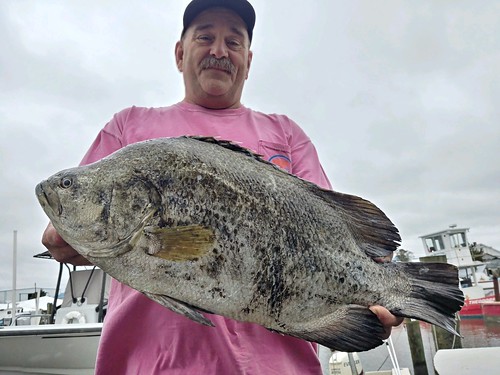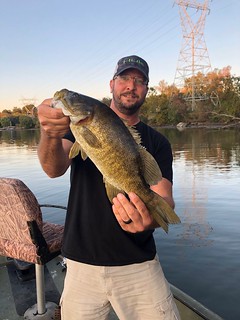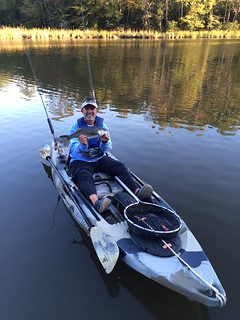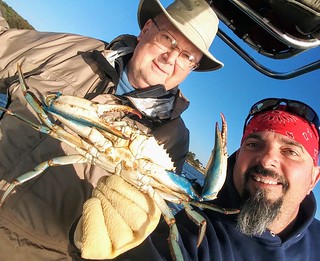
Photo by Steve Doctor
The stormy weather during September and October often bring fishy friends from southern waters to the coast of Ocean City. Don Whittington of Bivalve, Wicomico County, was fishing near some offshore lobster pot buoys recently when he caught an 11-pound tripletail, a new addition to our state record species list.
Forecast Summary: Oct. 23 – Oct. 29:
The recent, persistent north winds have mixed or “turned over” Bay waters. This means plenty of oxygen and temporarily uniform water temperatures from surface to bottom. So Bay fish have lots of cool, oxygenated waters to roam. Since rivers will continue to cool faster than the main bay, fish will move out of the rivers as they follow baitfish.
Where bait is present, anglers should focus on the shallower prime habitat areas during low light hours and deeper areas during the day. As always, make sure to focus on moving water periods for best results. Bay surface salinities are largely back to normal conditions.
Expect minor reduction in water clarity from algal blooms from Eastern Bay down to the Virginia state line, and on the Choptank, Patapsco and Severn rivers. To see the latest images from NOAA, check “Eyes on the Bay Satellite Maps.”
Water temperatures up and down the Bay have dropped from last week down to the mid to low 60s. Water temperatures at Little Falls have dropped to 60 degrees. Expect normal flows from most of Maryland’s rivers and streams this week with both the Susquehanna and the Potomac Rivers are running at average. There will be above average tidal currents from Thursday through the rest of the week as a result of the upcoming new moon Oct. 28.
For the full weekly fishing conditions summary and more detailed and up-to-date fishing conditions in your area of the Bay, be sure to check out Click Before You Cast. You can now get regular updates on Maryland’s waters and the creatures that call them home sent to your inbox with our new Eyes on the Bay newsletter. Sign up online.
Upper Chesapeake Bay

John McMullen holds up a big Susquehanna smallmouth for a picture. Photo courtesy of John McMullen
The Conowingo Dam pool has been a fun destination for those up early enough to enjoy some morning striped bass fishing. Casting topwater lures close to the dam’s power generation gates has been providing plenty of action, mostly sub-legal striped bass with a few keepers now and then. Wearing waders is a big advantage to help get as close as possible to make the long casts that are necessary. There are some large flathead catfish in the dam pool also and they can be caught on fresh cut bait; blue catfish are also becoming more common at the dam pool.
There is some jigging action for striped bass along the channel edges at the mouth of the Susquehanna River, and topwater fun along the edges of the flats. Most of the striped bass are sub-legal in size but provide some fun fishing. When fishing topwater near the edges of the flats, largemouth bass can sometimes be in the mix, and when jigging in the river channel edges large smallmouth bass can wind up taking a jig. The lower Susquehanna is noted for holding smallmouth bass weighing more than six pounds.
A mix of flathead, blue and channel catfish are found in the lower Susquehanna and the surrounding tidal rivers. River water temperatures are now in the low 60s so catfish are very active and can provide good fishing fun. Most any kind of fresh cut bait works well, as do clam snouts and chicken liver.
Fishing for white perch presents many opportunities in the tidal rivers and selected shoals of the upper Bay. The perch are holding in deeper water near piers and old submerged structure. Most anglers are using bottom rigs baited with pieces of bloodworms or grass shrimp. This is a wonderful time of the year to catch those larger filleting-size white perch.
Striped bass are spread throughout the region this week. The mouths of the tidal rivers offer good fishing for those casting topwater lures in the shallower areas during the early morning or late evening hours. Jigging along channel edges or under breaking fish can pay dividends with larger fish, and trolling is also a good option. Most of the breaking fish seen in the upper Bay tend to be small striped bass in the 12-inch to 15-inch range. The early morning and late evening hours tend to offer the best action.
The mouth of the Patapsco River and the Key Bridge piers have been great for drifting live eels. Love and Swan points can be holding striped bass along with the mouth of the Magothy and the Podickory Point channel edge. A few anglers are still live-lining spot. but that resource is beginning to thin out as cooler water temperatures settle in; small white perch can work just as well. Kent Narrows should not be overlooked and the Bay Bridge piers are also holding some striped bass. Anglers that are still live-lining are reminded that they must use circle hooks. Check our website and video for more information on circle hooks and careful release.
Middle Bay
There continues to be large numbers of small striped bass chasing schools of bay anchovies, which are moving out of the region’s tidal rivers now that water temperatures in most tidal rivers dip to 60 degrees this week. Small striped bass can be seen breaking along channel edges at the mouths of the region’s tidal rivers and along the steep edges of the shipping channel. Sometimes larger striped can be found lurking underneath and holding close to the bottom. Jigging with large soft plastics is a good tactic to target the larger fish. Another is slowly cruising along channel edges and watching a depth finder for telltale blips of larger striped bass suspended off the bottom.

Herb Floyd holds up a keeper from the Choptank River while fishing in his kayak. Photo courtesy of Herb Floyd
Striped bass fishing in the shallower waters of the tidal rivers is a fun way to fish with light tackle. Casting topwater lures, jerkbaits or crankbaits along shorelines is an exciting way to fish. Kayaks are a great way to access some of the quiet shoreline areas.
Trolling can be an option but larger lures need to be used to cut down on the number of small striped bass. Use medium-sized bucktail and hoses pulled behind umbrella rigs or in tandem or solo. Most of the larger fish are close to the bottom so heavy inline weights or planers will also need to be used. Bottom bouncing with bucktails can also be a good option in some areas.
There are still those who are live-lining spot and small white perch along the deeper channel edges are having some luck catching keeper-size striped bass. Thomas Point is still a popular place to live-line this week, but the larger fish tend to be much deeper than previously seen. Shallower depths are usually holding smaller fish. Anglers that are still live-lining are reminded that they must use circle hooks. Check our website and video for more information on circle hooks and careful release.
The Spanish mackerel are mostly gone now from the middle Bay and the red drum seem to have headed south as well. There are still a few bluefish in the region and fishing with sassy shads cut short will bear witness to that. The spot are still available but are showing evidence of thinning out as they start to move south for warmer waters.
Fishing for white perch is good in slightly deeper waters in the region’s tidal rivers. They are beginning to move to deeper waters so fishing with pieces of bloodworms or using grass shrimp on a bottom rig is a good way to catch them. Piers over deeper waters and oyster reefs are some of the best places to find them in the tidal rivers. For land-based anglers, Bill Burton Fishing Pier State Park at the lower Choptank River is an excellent place to catch white perch.
Lower Bay
The Middle Grounds offers what may be the last chance to catch a few Spanish mackerel. Most likely the bluefish will still be around, but they too will begin to feel the urge to head for more southerly waters as they follow the bay anchovies moving down the Bay. Earlier in the week there were reports of breaking fish at the Middle Grounds and the mouth of the Potomac River, made up mostly of small striped bass, with a mix of bluefish and Spanish mackerel.

Rich Watts and his friend John Turrall take a fun selfie with a jumbo-sized Miles River crab. Photo by Rich Watts
Those fishing in Eastern Shore rivers and in the lower Patuxent and Potomac have been enjoying some good light-tackle action for striped bass in the early morning and late evening. Casting poppers, crankbaits, and jerkbaits near shoreline structure and prominent points is a good tactic and a fun way to fish. Others are trolling a mix of bucktails, and spoons along the channel edges with some success. In the lower Potomac the steep channel edge between St. Georges Island and Piney Point still is a draw for those wishing to live-line spot. There tends to be a fair percentage of sub-legal fish in the mix but most agree it is worth the effort.
Speckled trout have been a fun diversion for many, as they are showing up on both sides of the bay and are a welcomed addition to light-tackle fishing. Casting a mix of topwater lures and shads has been a great way to catch them along marsh edges, prominent points, creek mouths and hard-bottom shoal areas. Most of the trout being caught are ranging from about 15 inches to 20 inches in length.
White perch are beginning to school up on hard oyster bottom in the lower sections of the region’s creeks and tidal rivers, providing plenty of fun fishing opportunities. Most are opting for bottom rigs baited with pieces of bloodworms or grass shrimp in water 10 feet or deeper. Deep-water piers and docks are great locations, as is fishing out of small boats.
The middle sections of the Potomac, Patuxent and Nanticoke rivers have large populations of blue catfish that are hungry for fresh cut bait or other items such as clam snouts. Most anywhere along the channel edges and some of the medium-depth holes are holding plenty of medium sized blue cats which make for the best eating fresh or frozen.
Recreational crabbers who are itching for that last fall batch of large and heavy blue crabs have been working the deeper waters of the tidal rivers, often as deep as 18 feet. Collapsible crab traps are the best option and one may have to add some extra line to those buoy lines. Razor clams and chicken necks have been the baits of choice.
Freshwater Fishing

Tom Wazniak holds up a nice Deep Creek Lake northern pike for a quick picture. Photo courtesy of Tom Wazniak
The fall trout stocking program is picking up speed. Some western and central region streams and rivers are seeing flow rates increase a bit due to recent rains, and therefore can handle larger loads of trout in the put-and-take areas. Be sure to check the trout stocking website to see which waters near you have been stocked recently.
Most put-and-take trout fishermen know that it is hard to beat Powerbait for recently stocked trout, but there can be other fun alternatives, especially after trout have been acclimated to their new environment for a few days. Using fly fishing tackle and working streamers or nymphs can be a fun and exciting way to fish. Those fishing with ultra-light spinning tackle can cover a lot of water by casting small spinners and spoons.
The upper Potomac River is seeing a little bump in better flows this week due to recent rain events. Smallmouth bass are being caught on small crankbaits, tubes, and grubs worked along current breaks and submerged ledges. Some of the deeper holes are holding the larger smallmouth bass and walleyes are beginning to come into play now as water temperatures cool down.
At Deep Creek Lake, most of the floating docks have been pulled so largemouth and smallmouth bass will be on the prowl for any type of cover. Sunken wood, rocks, fallen tree tops and grass lines are good places to look. Casting small crankbaits and jigs that resemble crayfish are a very good tactic. Crayfish are migrating from shallow cover to deeper cover and so have to cross open bottom, smallmouth bass in particular will be waiting in these transition areas to pick them off. Northern pike can be found along grass lines and cove mouths.
Crappie are actively schooling up near deep structure wherever they can find it. In larger reservoirs and tidal rivers, bridge piers are a good place to look. Sunken wood, fallen tree tops, and docks piers — whether in a small pond or a tidal river — are also good places to find crappie.
Colder water temperatures and diminished grass beds means that chain pickerel are very active and will be setting up ambush points near any kind of structure along shorelines. Sunken wood is one of the most common places for them to stage. A variety of lures will work to catch them. Declining grass beds also means that northern snakeheads can be found out in open water this time of the year, and popping corks or bobbers worked with a large minnow trailing is a good way to catch their attention.
Largemouth bass are moving into deeper transition areas, often in 10 feet to 16 feet of water in the tidal Potomac and other tidal rivers. The dropoff edges and especially structure is where they are holding and waiting for crayfish and baitfish moving from the shallower areas to deeper water where they’ll spend the winter months. Small crankbaits, grubs, and even blade lures in the deeper areas work well. Casting crankbaits, spinnerbaits and Rat-L-Traps from shallower waters toward the dropoffs is also a great tactic.
Atlantic Ocean and Coastal Bays
Anglers that are surf fishing this week are catching kingfish on pieces of bloodworms on bottom rigs. Northern puffers or blowfish are moving through the region and can be caught on pieces of clam or squid. Small bluefish are being caught on finger mullet or cut mullet. A few striped bass are being caught on cut bait.
At the inlet, tautog are being caught at the South Jetty and the bulkheads along the inlet waterway to the Route 50 Bridge. Sheepshead are also part of the mix at the South Jetty. Sand fleas and pieces of green crabs have been the most popular baits. Bluefish and striped bass are being caught by those casting bucktails and jigs.
Flounder are moving through the inlet to offshore waters this week. Unfortunately the waters in the inlet and channels of the back bay areas has been cloudy due to windy conditions; hopefully clearer waters will prevail with calmer weather. The channels leading to the inlet will be the best places to fish for flounder, the largest ones can be caught on larger baits such as live spot and finger mullet. Large Gulp baits on jig heads is another good bait to target the larger flounder.
Whenever conditions allow boats to head out to the wreck and reef sites, the sea bass fishing has been very good, with limit catches being common. Flounder are becoming a larger portion of the mix and triggerfish are still being caught.
The boats that are fishing the offshore canyons are finding a mix of species. The white marlin have been thinning out but some wahoo, swordfish and yellowfin tuna have been brought back to the docks recently. Many are also working the lobster pot buoys to take advantage of the last of the chicken dolphin that are holding there.
“The most indispensable item in any fisherman’s equipment is his hat. This ancient relic, with its battered crown and well-frayed band, preserves not only the memory of every trout he caught, but also the smell.” — Corey Ford, 1952
Maryland Fishing Report is written and compiled by Keith Lockwood, Maryland Department of Natural Resources fisheries biologist.
Click Before You Cast is written by Tidewater Ecosystem Assessment Director Tom Parham.
This report is now available on your Amazon Echo device — just ask Alexa to “open Maryland Fishing Report.”
